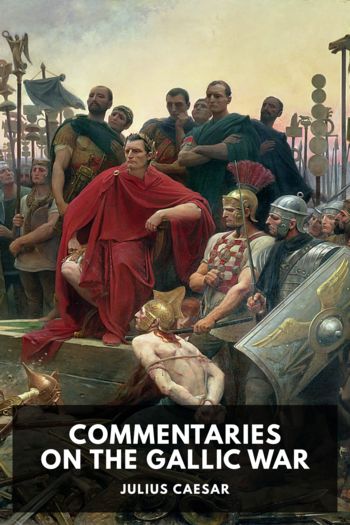Fateful Lightning: A New History of the Civil War & Reconstruction by Allen Guelzo (icecream ebook reader txt) 📗

- Author: Allen Guelzo
Book online «Fateful Lightning: A New History of the Civil War & Reconstruction by Allen Guelzo (icecream ebook reader txt) 📗». Author Allen Guelzo
Poor William Henry Harrison died in 1841, only one month after his inauguration as president, and the Whig Party suddenly found itself saddled with John Tyler, Harrison’s vice president, as the country’s chief executive. Although Tyler was nominally a Whig, he soon found himself at odds with Henry Clay and Daniel Webster, the real chiefs of the Whig Party, and two men who were sure that they deserved the presidency more than the man people sneered at with the sobriquet “His Accidency.” Every bill that Clay and a Whig Congress wrote for the pet projects of the Whigs—internal improvements, protectionist tariffs, a new Bank of the United States—was vetoed by Tyler, and eventually all the Whigs in the Cabinet resigned. Shunned by the Whigs, Tyler tried to assemble his own independent political power base, and as a Virginian and a slaveholder, he was not shy about bidding for Southern support. As bait to his fellow Southerners, Tyler and his new secretary of state, Abel Upshur, negotiated an annexation treaty for Texas and tried to turn Texas annexation into a campaign issue that Tyler could ride back into the White House in 1844 as a “Southern candidate.” Texas, as Upshur told one of John Calhoun’s political allies, is “the only matter, that will take sufficient hold of the South and rally it on a Southern candidate and weaken Clay and Van Buren.”8
Tyler succeeded in making Texas an issue, but not himself president. The Democrats snubbed the unhappy Tyler and ran one of Andrew Jackson’s old lieutenants, James Knox Polk of Tennessee, for the presidency in 1844. The Whigs had no time at all for Tyler and put up Henry Clay instead, hoping to feed on fears that an annexation of Texas would provoke war with Mexico. Clay undercut his own candidacy by conceding to Southern Whigs that he might be willing to accept the annexation of Texas if could be done “without dishonor, without war, with the common consent of the Union.” What Clay gained among the Southern Whigs he promptly lost among the Northern ones, and Polk squeezed into the White House after winning Pennsylvania and New York with majorities of only 7,000 votes.9
There was no question about James Knox Polk’s plans for Texas—Polk was an outright annexationist, and even hoped to edge the British out of Oregon—and so before his inauguration the disheartened Whigs gave up the fight and allowed a joint congressional resolution to adopt the Texas annexation treaty in December 1844. The Mexican government did not back down in the face of Polk’s determination to have Texas, withdrawing its ambassador from Washington in protest. Sensing trouble (and not finding trouble with Mexico all that unwelcome), President Polk sent Brigadier General Zachary Taylor to the Texas border with 1,500 United States soldiers in July 1845. Ten months later, there was a bloody clash between Mexican and American troops over a disputed border area, and Polk used the clash as an excuse for rallying Congress to declare war on Mexico on May 13, 1846.
The Mexican War was, compared to the Alamo and San Jacinto battles, a relatively unglamorous affair. The American forces were divided into four small field armies under John Ellis Wool, Zachary Taylor, Stephen Kearny, and Alexander Doniphan for the invasion of Mexican territory. Taylor (alongside Wool) won a major victory over Santa Anna at Buena Vista and occupied most of northern Mexico. Kearny plunged into New Mexico and chased Mexican forces from Santa Fe, then moved on into southern California, where scattered colonies of American settlers helped him overthrow the Mexican provincial government. The greatest laurels were won by Major General Winfield Scott, who led a daring invasion column from Mexico’s Gulf coast inland to Mexico City, which fell to Scott on September 13, 1847. No less a military authority than the victor of Waterloo, the Duke of Wellington, had predicted at the outset that “Scott is lost. He has been carried away by his successes! He can’t take the city, and he can’t fall back upon his base!” But when Scott indeed captured Mexico City, the Iron Duke generously reversed himself: “His campaign was unsurpassed in military annals. He is the greatest living soldier.”10
The following February, the Treaty of Guadalupe Hidalgo was signed, with Mexico grudgingly surrendering to the United States the territory that is now New Mexico, California, and parts of Arizona, Colorado, Utah, and Nevada. As if to illustrate that fortune favors the bold (or at least the unscrupulous), no sooner was California an American possession than one James Marshall discovered gold in a streambed near Sacramento, thus setting off the mighty California gold rush and stampeding thousands of American settlers into the newly acquired territories.
It was at this point that the old balancing game of threats and assurances began again.
The Missouri Compromise had settled what to do with the half of the far West that the United States had owned in 1820; the





Comments (0)